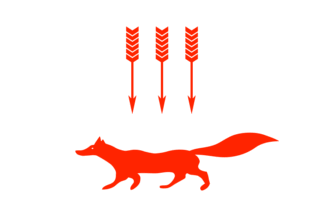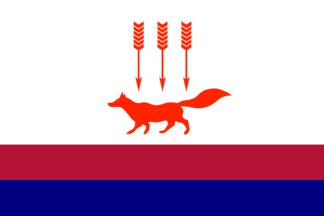 image by
Tomislav Šipek, 5 December 2019
image by
Tomislav Šipek, 5 December 2019
Last modified: 2021-12-31 by valentin poposki
Keywords: saransk | fox | arrows |
Links: FOTW homepage |
search |
disclaimer and copyright |
write us |
mirrors
 image by
Tomislav Šipek, 5 December 2019
image by
Tomislav Šipek, 5 December 2019
On February 3, 2011, the city council of deputies, by Decision No. 675 (http://www.vexillographia.ru/russia/texts/2011_saransk.doc),
approved a new version of the city flag: "The flag of the Saransk urban district
is a rectangular white cloth with a ratio of width to length of 2: 3, in the
center of which are three vertically placed red arrows pointing down, below
which is a red fox coming close to the hoist.
The flag was entered in the
State Heraldic Register of the Russian Federation under No. 9244 (https://geraldika.ru/symbols/21714)."
Source:
http://www.vexillographia.ru/russia/subjects/towns/saransk.htm
For
additional information go to Saransk (official website):
http://www.adm-saransk.ru/
Esteban Rivera, 18 June 2018
 image by
Tomislav Šipek, 5 December 2019
image by
Tomislav Šipek, 5 December 2019
The flag shows the fox and the arrows on the main field of an unequal
horizontal tricolor of white (2/3rds of the total height), red, and blue;
specs thus (6+1+1):12 = 2:3. The legal text, "Act #140 of Council of
Deputies of the City District of Saransk" as quoted in the Wikimedia
Commons page, in Viktor Lomantsov’s website dated of 2008.09.10
http://www.vexillographia.ru/russia/subjects/towns/saransk.htm,
states that the stripes are "белого, маренового
(темно-красного) и
темно-синего" —
"white, Wild Madder colored (dark red) and dark
blue". Note yet another way to refer to dark red, and that dark blue is
prescribed, not just a translation of sinniĭ to distinguish from
goluboĭ (sky-blue, light blue) as usual when translating Russian
vexillological texts. The same text prescribes "красную
(червленую) лису" (…)
"три красных (червленых) стрелы", giving a
different word for the
shade of red of the fox and arrows — krasniĭ (ĉervlënyĭ), this being
regular medium red.
António Martins-Tuválkin, 17 May 2010